Only $99 for a full year!
No credit card required
Rank on Google's first page in 3 months
New to SEO? Here’s How to Optimize Your New Website
Jul 30, 2024 | user
You’ve just launched your new website, and you’re eager to attract the right audience. Optimizing your website for search engines is important to ensure it is easily discoverable by potential customers. A strong new website SEO strategy is the key to driving targeted traffic.
Search Engine Optimization involves improving your site’s visibility and ranking in search engine results pages. By implementing effective SEO tactics from the start, you’ll lay a proper foundation for a successful online presence.
This blog will provide essential guidance on optimizing your new website for search engines.
Setting Up Your New Website SEO for Success
An SEO strategy combines methods that improve a website’s search engine rankings. The goal is to drive more traffic and ultimately increase conversions. This strategy comprises many proven practices and advanced techniques to significantly enhance a website’s visibility on search engine results pages.
1. Choose A Proper Domain Name.
Select a proper domain name for your business. It needs to be short and catchy, describing your website business.
- Select a domain name on your website that is easy to spell and remember.
- Choose an appropriate extension like .com, .net, or industry-specific ones like .tech
- Check for existing trademarks to ensure your domain name is unique and original. This will prevent legal disputes and give you a secure online presence.
- Pick a domain name that allows for future growth and doesn’t limit your business scope or geographic area.
- While keywords in the domain can help SEO, you must balance it with brand-ability.
- Avoid overloading with keywords in your domain name to ensure your SEO strategy is effective and user-friendly.
2. On-Page Optimization
On-page SEO is called optimizing website pages to rank higher in search results. This involves improving elements like title tags, meta descriptions, header tags, and content relevance. By aligning your page content with search intent and providing a great user experience, you can attract organic traffic.
a. Keyword Research
As always, starting SEO strategies with proper keyword research is important. You need to target relevant keywords that help you in becoming more visible in search results. So you need to perform a proper keyword research to find the right words and phrases people use to find your website.
There are so many keyword research tools that help you in getting the proper keyword for your website. You can try any site like SEMrush, Ahrefs, or UberSuggest to get proper keywords for your website.
Remember to take consideration of the search intent behind your keyword research, because proper understanding of this will help you get the apt keyword. Add the selected keywords to a sheet by adding the keyword volume and keyword difficulty.
b. Optimize Title Tag
Optimizing title tags is an important factor in on-page optimization. This will tell google what your page is about, and when it’s hooky, users can easily click through it, and you will get more impressions. You can include the primary keyword of the page in the title tag without doing any stuffing. Also, remember to make the title tag length up to 60 characters, including spaces.
c. Add Keywords to your Website Content
Integrating keywords into your website’s content is another main aspect of page SEO. You can strategically place relevant keywords throughout your website content without any stuffing. Add the primary keyword in H1 and the first paragraph, and add secondary and LSI keywords scattered throughout the content.
Remember that you are always writing content for your users, not the search engines.
- Title Tags: Clearly and concisely reflect the page’s Content and include your primary keyword.
- Meta Descriptions: Create compelling summaries that include your target keyword.
- Header Tags: Use header tags(h1, h2, h3, h4..) to structure your site content and incorporate keywords naturally.
- Body Content: Integrate keywords organically within your text, ensuring readability and relevance.
- Image Alt Text: Use descriptive alt text for images that include relevant keywords.
- URL Structure: Include keywords in your URL, making it informative and user-friendly.
SuiteJar’s content marketing tool includes a feature called “Google First Page Ranker,” which provides valuable insights into the pages with the highest potential to rank on Google’s SERP.
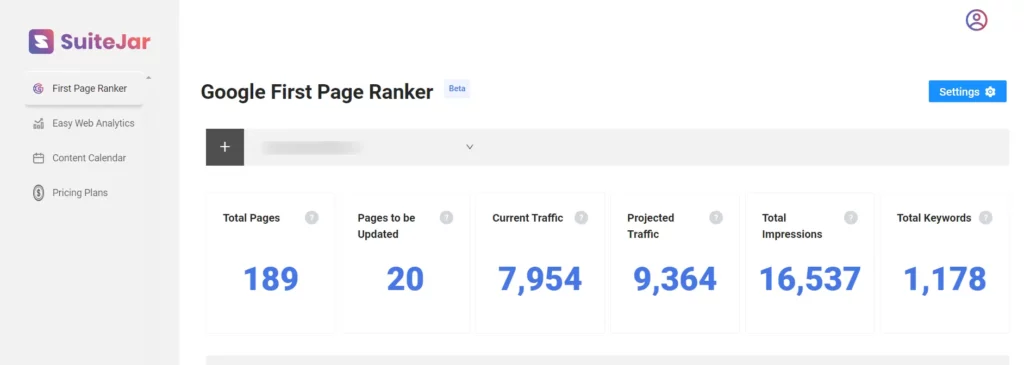
The First Page Ranker feature analyzes your entire website content and then presents a list of web pages with the highest potential to rank on the first page once optimized. You will get more insights such as the keyword that the webpage is ranking and know the suggested keywords to add.
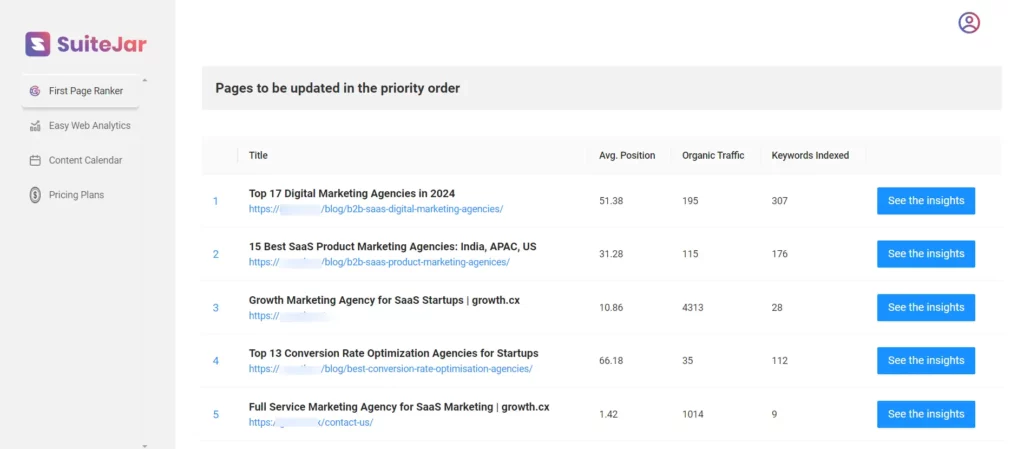
Also, there are factors that are missing on the webpage, like internal and backlinks. You can easily undergo these insights and make your webpage on the first page of SERP.
d. Improve Internal Links
By implementing a well-thought-out internal linking strategy, you can enhance your website’s overall SEO performance and provide a better user experience. When you are linking the text you are using to give the link is anchor text The anchor text needs to be a clickable one. You can add the proper keywords in your anchor text that help you in your SEO and make it clear and descriptive anchor text.
Further Read: Ultimate On-Page SEO Checklist for 2024 for Ranking Higher

3. Technical SEO Strategies
Technical SEO acts like a backbone of your website, and it helps you to build a strong online presence. It involves optimizing your website’s technical aspects to improve search engine visibility and user experience.
a. Website Speed Optimization
The speed of a website is the primary ranking factor for search engines. Slow-loading pages lead to higher bounce rates on your site and lower user engagement. These slow loading negatively affect your site’s ranking and overall performance. You can take care of these steps to make your website technically fit for SEO.
- Optimize server settings and choose a faster hosting plan to ensure your site loads quickly.
- Make sure your website images are compressed and in modern formats like WebP to reduce their size without losing quality. This helps in speeding up your site’s load time.
- Reduce delays in loading your website by deferring or loading JavaScript and CSS files asynchronously. Also, simplify your HTML to make the content appear faster.
- Cut down on non-essential images if your website has any. It can use plugins, functions, and images to make your site load quicker and run more smoothly.
- Limit redirects to prevent extra delays, which can slow down your site and frustrate users.
- Use browser caching to store certain elements of your site on users’ devices so they don’t have to reload them every time they visit, speeding up their experience.
b. Website Mobile-Friendliness
With more people browsing the web on their smartphones than on desktop computers, having a mobile-friendly website is important. Google always prioritizes the mobile version of your site for indexing and ranking. You can make your website to friendly by following these tips;
- Responsive Design: Make sure your site properly functions smoothly on any device, whether it’s a smartphone, tablet, or desktop computer. This is achieved through responsive design and this approach automatically adjusts your website’s layout and elements to fit different screen sizes.
- Mobile Page Speed: Speed is necessary on mobile devices where users expect fast-loading pages. Improve your site’s mobile speed by optimizing images, which means compressing them so they load faster without losing quality. You can also use AMP (Accelerated Mobile Pages) to create faster-loading mobile pages.
- Simplified Navigation: Ensure that your website’s navigation is straightforward and simplified. Use clear, easily accessible menus and avoid large pop-ups or elements that might be difficult to interact with on mobile devices. This will help your target users find what they need easily, improving their overall experience on your site.
c. XML Sitemap
An XML sitemap acts as a roadmap for search engines. This will guide them through your website and help them find all your important pages. This ensures that everything is noticed and that your site is indexed correctly.
- Choose a Sitemap Tool: Select a tool or plugin to generate your XML sitemap. For WordPress, plugins like Yoast SEO or Google XML Sitemaps are popular options. For other platforms, use online sitemap generators.
- Install and Configure the Tool: If using a plugin, install it via your website’s admin dashboard. Configure the plugin to include the pages and exclude those you don’t want to be indexed.
- Generate the Sitemap: Use the tool to create the XML sitemap. This process usually involves clicking a button to generate the sitemap file.
- Review the Sitemap: Check the generated sitemap to ensure it includes all important pages and excludes any unnecessary ones.
- Save and Upload the Sitemap: Save the XML file to your website’s root directory (e.g., www.yoursite.com/sitemap.xml).
- Submit to Search Engines: Log into Google Search Console and Bing Webmaster Tools. Navigate to the sitemap submission section and submit the URL of your sitemap.
- Monitor and Update: Regularly check and update your sitemap to reflect any changes to your website’s structure or content. Re-submit the updated sitemap to search engines if necessary.
d. Robots.txt File
A robots.txt file acts as a guide for search engines, telling them which parts of your website they’re allowed to crawl and index and which parts they should avoid. This is to ensure that search engines focus on your most important pages and don’t waste their resources on less significant ones. Here’s how to set up and manage a robots.txt file:
- Start by creating a simple text file named robots.txt. This file needs to be placed in the root directory of your website (e.g., www.yoursite.com/robots.txt).
- Use specific directives to control what search engines can and cannot access.
- Disallow means to inform search engines not to crawl certain pages or sections. And Allow permits access to specific pages, even if other parts are blocked.
- Save your changes and upload the robots.txt file to your website’s root directory.
And as a bonus tip you can select an easy-to-use web analytics tool, such as SuiteJar, which provides user-friendly interfaces and essential insights without complexity.
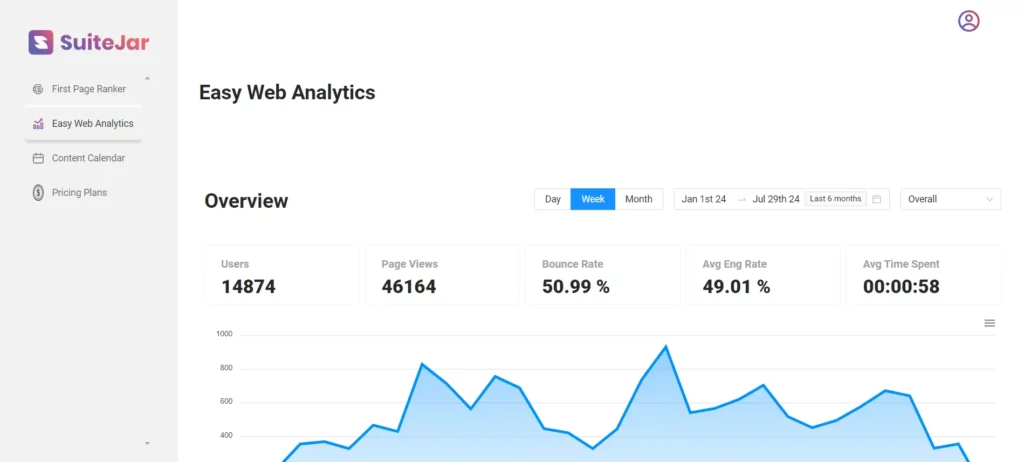
You can ensure that key events and conversions are set up to track user interactions effectively. Regularly check your analytics dashboard to track important metrics like page load times, user behavior, and traffic sources.
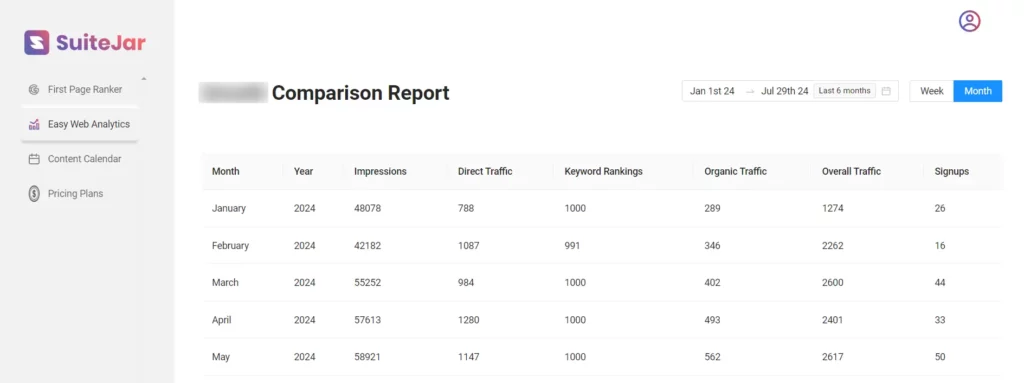
Use this data to identify areas for improvement and make informed decisions. By integrating an easy web analytics tool into your technical SEO checklist, you gain insights into your website’s performance.
These are the basic SEO tactics that you need to use on your new website. You can refer to this technical SEO checklist blog to learn more strategies.
4. Proper Content Strategy For SEO
Creating SEO-optimized content for improving your website’s search engine rankings. Website having high-quality, relevant content attracts and engages your audience. Also it makes sure the search engines that your site is a valuable resource. Here’s how to develop an SEO content strategy,
a. Define Your Goals
The basis of a successful SEO content strategy is a clear understanding of your objectives. Defining your goals will provide direction and a benchmark for measuring success. Having clear goals helps in achieving higher positions in SERPs for relevant keywords. It will encourage visitors to take specific actions, such as signing up for a demo or making a product purchase.
b. Consider Your Audience
Understanding your target audience clearly is important for creating content that resonates and drives engagement. You can conduct thorough research to identify who your audience is and what they are looking for. Look at their age, gender, location, income level, education, and other demographic information.
Also, know,
- What topics are they interested in?
- What type of content do they prefer (e.g., blogs, videos, infographics)?
- What problems are they trying to solve?
- How can your content provide solutions?
- What terms and phrases are they using in search engines?
- What questions are they asking?
By understanding the answers to these questions, you can create content that addresses your audience’s needs and interests, ultimately driving more engagement and conversions.
c. Create a Strategic Content Calendar
A content calendar is a proper strategy that helps you prepare, manage, and organize your content production and publishing. It ensures consistency in your content publication. Also helps you stay on track with your content strategy.
- Create a list of relevant topics that align with your goals and audience interests. Use seo tools like google trends to identify trending and relevant topics.
- Then, identify proper keywords to target in your content.
- Look at what your competitors are doing and identify gaps or opportunities.
- You can then create a content calendar template to enter these details properly.
- Make correct columns for inserting all the sections like topic name, keyword, keyword volume, keyword difficulty, type of funnel and more.
So setting up these will be a bit stressful for you. This has to be done with so much researching and identifying topics for your niche.
You all know google is a vast sea that you have to search for the right one with proper researching. Forget all this when you have a Content Calendar Generator. A content calendar generator helps you to get as much topic for you with proper analyzing of your niche.
Using SuiteJar’s AI-powered content calendar generator, you can plan your content in no time. Using it is easy and it ensures that you stay organized without any hassle. The tool provides as many topics as you want in your website blog content. You only need to enter some details like,
- Website URL
- Business Type
- About your product/service
- What problem does your product/service solve
- How does it stand out from competitors
- Your competitor’s websites
- Location
- Your Target Audience
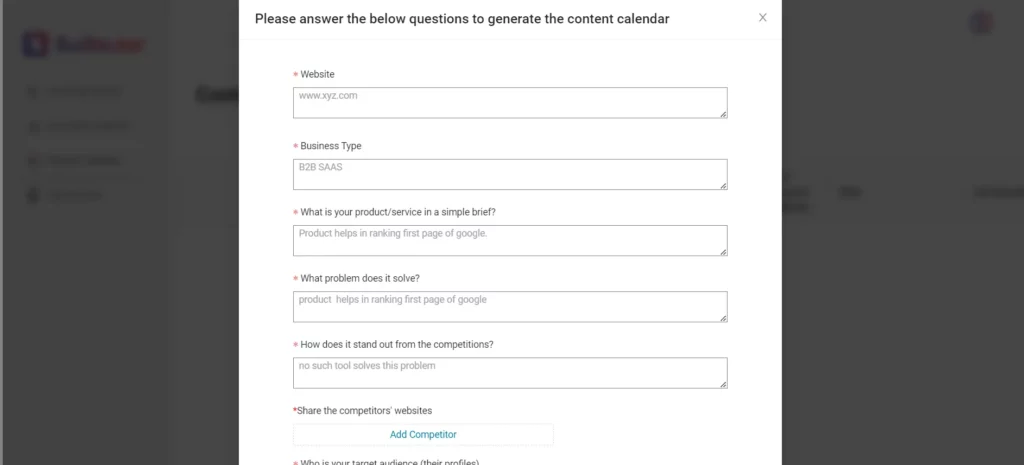
Then, you can just submit the details, and then you will get the proper keywords for your website. There is an option for adding the keyword you are using on your website. It is all needed to get a perfect content calendar with all the details as a perfect sheet. It is much easier than manually entering your content calendar.
Regularly analyze your site content to maintain an effective SEO strategy. It helps you understand what is working in your website content and ensure your content remains relevant and valuable. Look for high-performing content that can be updated or repurposed and low-performing content that needs improvement.
Also, look for content gaps that can be filled with new topics or provide deeper coverage of existing topics. This makes sure your content is optimized for current SEO best practices, including keyword usage, meta descriptions, and internal linking.
5. Off-Page Optimization
Off-page SEO means the activities you perform outside your site to improve its search engine rankings. Unlike on-page SEO, which focuses on optimizing elements within your website, off-page SEO aims to establish your site’s authority, credibility, and relevance through external factors.
a. Build High-Quality Backlinks
Backlinks are one of the most critical components of off-page SEO. They will signal to search engines that your content is valuable and trustworthy. You can use guest blogging, content marketing, outreach campaigns, broken link building, and participate in forums and communities.
b. Crafting a Better Social Media Strategy
A strong social media strategy is vital for off-page SEO as it amplifies your content, increases visibility, and drives traffic to your website. Share the content that resonates with your audience, such as blog posts, infographics, videos, and interactive content.
Make sure your content is visually appealing and adds value. Also, publish regularly to keep your audience engaged and informed and develop a content calendar to plan your posts and ensure consistency.
Further Read: The Complete Off-Page SEO Guide for 2024
Conclusion
While starting SEO might seem complex at first, it makes your website better for both search engines and real people. By focusing on on-page SEO, creating high-quality content, optimizing your website’s structure, and building a strong online presence, you’re laying the base for long-term success. With constant effort and a proper SEO tool, you’ll see your website rise in search engine rankings and attract more visitors.

